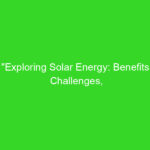
Passive and Active Solar Energy
Solar energy is the most abundant and renewable source of energy available on our planet. It is a clean and sustainable alternative to fossil fuels and can help reduce greenhouse gas emissions and combat global warming. There are two types of solar energy: passive and active solar energy. In this article, we will explore the differences and benefits of each.
Passive Solar Energy
Passive solar energy is the process of using the sun's energy to heat and cool buildings without the use of mechanical systems. This is achieved by designing and orientating buildings to maximize the sun's natural light and heat. Passive solar energy is free, requires minimal upkeep and has no environmental impact.
Benefits of Passive Solar Energy
-
Lowers energy bills: Passive solar energy can lower energy bills by up to 50% by reducing the need for heating and cooling systems.
-
Increases comfort: Passive solar energy can increase comfort levels in homes and buildings by reducing temperature fluctuations and providing natural light.
-
Reduces carbon footprint: Passive solar energy reduces the carbon footprint of buildings by using renewable energy instead of fossil fuels.
Passive Solar Energy Techniques
There are several techniques used in passive solar energy design, including:
-
Orientation: Buildings should be designed to face the sun to maximize the amount of natural light and heat that enters the building.
-
Insulation: Proper insulation is essential to prevent heat loss during the winter and heat gain during the summer.
-
Thermal Mass: The use of materials such as concrete and stone to store and release heat slowly can reduce temperature fluctuations.
-
Ventilation: Proper ventilation can help regulate temperature and improve indoor air quality.
Active Solar Energy
Active solar energy is the process of using mechanical systems such as solar panels and solar water heaters to convert the sun's energy into usable electricity or hot water. Active solar energy requires specialized equipment and installation to function.
Benefits of Active Solar Energy
-
Energy independence: Active solar energy can provide energy independence by allowing homeowners and businesses to generate their electricity and hot water.
-
Financial savings: Active solar energy can provide long-term financial savings by reducing or eliminating electricity and hot water bills.
-
Environmental benefits: Active solar energy reduces the use of fossil fuels, reducing carbon emissions and contributing to a cleaner environment.
Active Solar Energy Techniques
There are several active solar energy techniques, including:
-
Solar Panels: Solar panels are used to convert sunlight into electricity. They are typically placed on rooftops and require a sunny location.
-
Solar Water Heaters: Solar water heaters are used to heat water for domestic use. They are typically installed on the roof and require a sunny location.
-
Solar Pumps: Solar pumps are used to circulate water in swimming pools, fountains, and irrigation systems.
Conclusion
Both passive and active solar energy are great alternatives to traditional fossil fuel-based energy sources. Passive solar energy is an ideal option for those looking for a low-maintenance, cost-effective solution to energy needs, while active solar energy is ideal for those looking to reduce their carbon footprint while achieving energy independence. Making the switch to solar energy can help reduce greenhouse gas emissions, combat global warming, and create a cleaner, more sustainable future for all.





